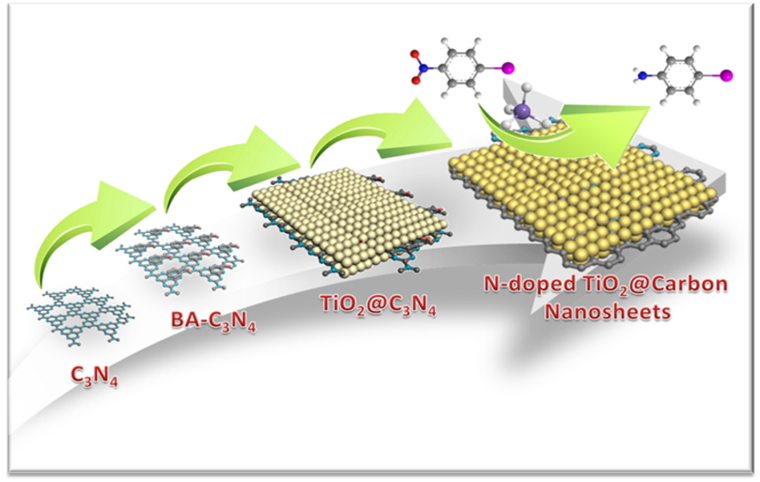Catalytic nitro reduction is an important transformation in synthetic organic chemistry. Usually, this reaction is strongly dependent on the well-developed noble metal catalysts. However, due to the scarcity, prohibitive cost and low durability of noble metals, their applications are greatly limited.
Prof. YI Zhiguo's group at Fujian Institute of Research on the Structure of Matter (FJIRSM), Chinese Academy of Sciences (CAS) has developed an efficient, stable and cost-effective catalyst based on earth-abundant TiO2 and carbon to catalyze the selective reduction of nitro compounds. This work has been published in ACS Catalysis.
In this study, the earth abundant, chemically stable but inactive TiO2 is successfully transformed into a highly efficient catalyst for nitro reduction. This progress is achieved by using C3N4 as a multifunctional structure-directing agent. During synthesis, the shape, size and crystal phase of TiO2 are controlled by C3N4. In addition, C3N4 also acts as a source of nitrogen for doping into both TiO2 and the carbon nanosheets.
As a result, defective and nitrogen-doped TiO2@carbon nanosheets are obtained. The as-obtained catalyst shows highly efficient catalytic performance for selective nitro reduction, which is comparable to the Au-based catalyst. The N-TiO2@C catalyst can overcome the drawback of widely investigated Au catalyst in such kind of reactions and exhibits long term durability in the recycled catalytic reactions.
In distinct contrast to the noble metal mediated nitro reduction process, a new catalytic mechanism for nitro reduction has been proposed based on the synergistic effect between the oxygen vacancies and substituted nitrogen dopants in N-TiO2@C. That is, the oxygen vacancies promote the adsorption and activation of nitro groups while the nitrogen dopants facilitate the hydrogenation of the nitro groups.
The work not only provided a way to design efficient, low-cost and stable catalysts for selective nitro reduction, but also pointed to the new possibility of utilizing C3N4 as a promising structure-directing agent for tailored design and synthesis towards a variety of material science applications.
This team has also realized efficient hydrocarbons oxidation under mild conditions by rational design the structure of the catalyst. These works have been published in ACS Appl. Mater. Interfaces, J. Mater. Chem. A, Phys. Chem. Chem. Phys., and Nature Commun.
This work was supported by the National Key Project on Basic Research, Strategic Priority Research Program of the Chinese Academy of Sciences, the National Natural Science Foundation of China, and Natural Science Foundation of Fujian Province.

Figure: C3N4 directed synthesis of nitrogen-doped TiO2@carbon nanosheets for selective nitro reduction (Image by Prof. YI's Group)
Contact:
Prof. YI Zhiguo
Fujian Institute of Research on the Structure of Matter
Chinese Academy of Sciences
Email: zhiguo@fjirsm.ac.cn